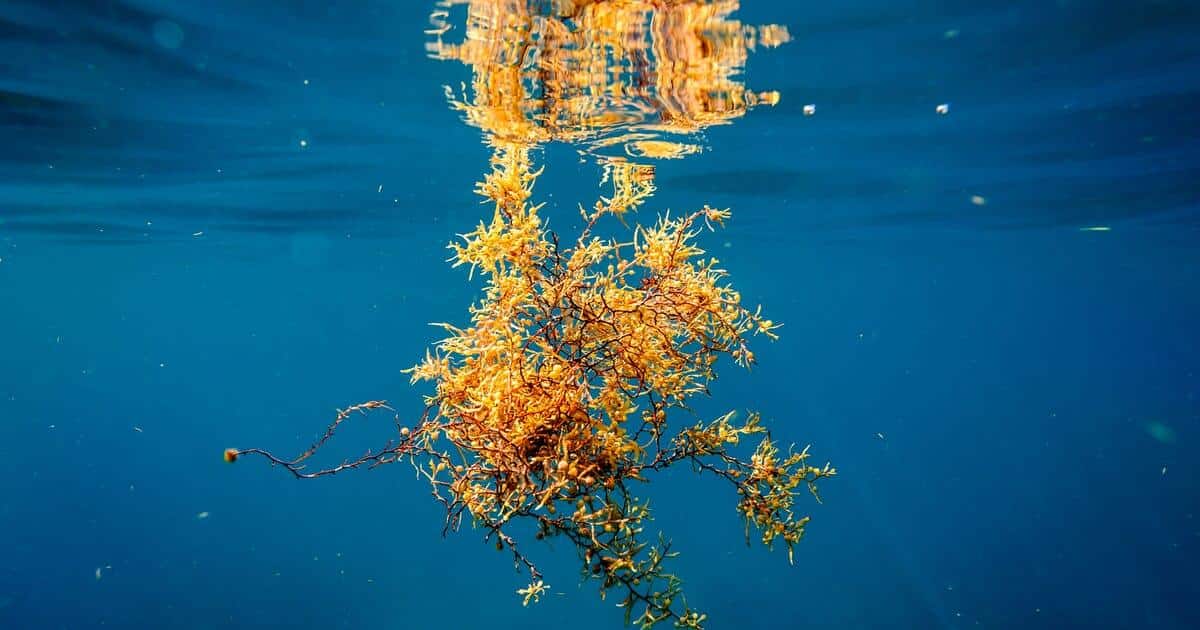
Have you ever wondered what kinds of plants grow in the ocean? Ocean plants are incredibly important for maintaining the health of marine ecosystems. They produce more than 50% of the oxygen we breathe!
From the vast kelp forests to tiny phytoplankton, ocean plants not only provide food and shelter for marine animals, but they also play a crucial role in stabilizing underwater environments.
Some even help build coral reefs and sandy beaches. These plants are found worldwide, from shallow coastal waters to deep ocean floors.
In this list, we’ll explore 14 different types of ocean plants, highlighting their unique features and important roles in the ocean.
List of Plants Found in the Ocean
1. Seagrass

- Scientific Name: Zostera (various species)
- Appearance: Long, thin, grass-like blades, green in color.
- Region: Coastal waters worldwide, especially in shallow areas.
- Role in Ecosystem: Provides habitat and food for marine life, stabilizes the seafloor, and produces oxygen.
2. Halimeda

- Scientific Name: Halimeda (various species)
- Appearance: Green, segmented algae that look like flattened disks.
- Region: Found in tropical and subtropical waters, especially near coral reefs.
- Role in Ecosystem: Secretes calcium carbonate, contributing to the formation of sandy beaches and coral reefs, and provides habitat for small marine organisms.
3. Sargassum

- Scientific Name: Sargassum (various species)
- Appearance: Brown, leafy algae with small, air-filled bladders that allow it to float.
- Region: Warm waters, particularly in the Sargasso Sea in the Atlantic Ocean.
- Role in Ecosystem: Provides habitat for marine life, including fish and sea turtles, and serves as food for some species.
4. Red Algae

- Scientific Name: Rhodophyta
- Appearance: Red to purple in color, with branching, leaf-like structures.
- Region: Found in deeper, colder waters around the world.
- Role in Ecosystem: Supports coral reef formation and is a food source for herbivorous marine species.
5. Green Algae

- Scientific Name: Chlorophyta
- Appearance: Bright green, can be sheet-like or filamentous.
- Region: Shallow, coastal waters globally.
- Role in Ecosystem: Produces oxygen through photosynthesis and provides food for marine animals like fish and sea turtles.
6. Coralline Algae

- Scientific Name: Corallinales
- Appearance: Hard, encrusting algae with pink to red hues.
- Region: Found in tropical and temperate ocean waters, often around coral reefs.
- Role in Ecosystem: Builds coral reefs by secreting calcium carbonate, helping maintain reef structure and stability.
7. Sea Lettuce

- Scientific Name: Ulva lactuca
- Appearance: Thin, translucent, green leaves that resemble lettuce.
- Region: Shallow coastal waters, found globally.
- Role in Ecosystem: Provides food for marine herbivores and helps oxygenate the water.
8. Phytoplankton

- Scientific Name: Various species, including Diatoms and Dinoflagellates.
- Appearance: Microscopic, single-celled organisms, often greenish in color.
- Region: Found throughout the world’s oceans, floating in the water column.
- Role in Ecosystem: Produces oxygen through photosynthesis and forms the base of the marine food chain.
9. Giant Kelp

- Scientific Name: Macrocystis pyrifera
- Appearance: Massive brown algae with long, ribbon-like fronds; can grow over 100 feet.
- Region: Cold, nutrient-rich waters, especially off the coasts of North and South America.
- Role in Ecosystem: Creates underwater forests that provide habitat and food for a wide variety of marine species.
10. Eelgrass

- Scientific Name: Zostera marina
- Appearance: Long, green, ribbon-like leaves.
- Region: Shallow waters along temperate coasts, especially in the Northern Hemisphere.
- Role in Ecosystem: Stabilizes sediment, provides habitat for fish and invertebrates, and helps produce oxygen.
11. Mermaid’s Hair

- Scientific Name: Chlorodesmis fastigiata
- Appearance: Fine, hair-like green filaments.
- Region: Warm, shallow coastal waters, typically found in the Indo-Pacific.
- Role in Ecosystem: Provides food for herbivores and helps with nutrient cycling in reef environments.
12. Feather Boa Kelp

- Scientific Name: Egregia menziesii
- Appearance: Long, rope-like, brown fronds with feathery edges.
- Region: Pacific coast of North America.
- Role in Ecosystem: Provides habitat and shelter for small marine species and helps stabilize underwater ecosystems.
13. Bubble Algae

- Scientific Name: Ventricaria ventricosa
- Appearance: Spherical, bubble-like, bright green structures.
- Region: Found in tropical and subtropical oceans, particularly around coral reefs.
- Role in Ecosystem: Acts as a food source for some marine species and contributes to the nutrient cycle within reef ecosystems.
14. Padina

- Scientific Name: Padina pavonica
- Appearance: Fan-shaped, brownish algae with white edges.
- Region: Shallow, warm waters of tropical and subtropical oceans.
- Role in Ecosystem: Provides shelter for small marine organisms and contributes to reef-building through calcium carbonate deposition.
Conclusion
Ocean plants are essential to the health of our planet and marine ecosystems.
They provide food, oxygen, and shelter for countless marine animals while also helping to stabilize underwater environments.
From the towering kelp forests to the tiny but powerful phytoplankton, each plant plays a unique role in keeping our oceans balanced.
Many of these plants also contribute to forming coral reefs and even the sandy beaches we enjoy.
By understanding more about these plants, we can appreciate their importance to life in the ocean and on land.
Protecting these plants is crucial for maintaining the health of the oceans and, ultimately, the entire planet.

